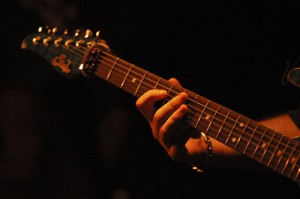A Holistic Organized Approach to Fretboard Mastery

Every once in a while, a student gets to the point where they covered so much material in such a short time, that they feel like they don’t see the forest through the trees anymore.
Part of the reason for this is that it is overwhelming to practice a billion things in 12 keys.
There is power and value in spending some time, let’s say an entire week for example, where you do everything you ever learned in 1 key only for the entire week.
That is why I call this a “holistic approach” to practicing and to fretboard mastery.
For an entire week, you focus on every chord, every arpeggio, every triad, every 7th chord fingering, every pentatonic scale fingering, every 7 note scale fingering, every fretboard exercise, every triad on every string set, every relative scale, every interval on every string set, and so on… ALL in the same key.
I can assure you: 7 days later you will become so much closer to being a master guitarist in that key.
Some of the below exercise names (Like for example “never-ending scale”) will prob not make sense to you if you haven’t taken guitar lessons with me yet
This Is Basically A Practice Schedule in 1 Key
Let’s use the key of Eb as an example
1. Never Ending Scale in Eb
2. Never Ending Scale in all intervals: 3rd, 4ths. 5ths, 6ths, and 7ths in Eb
3. Single String Playing in Eb
a. 3-note phrases
b. Using the correct fingerings
c. Make it interesting with:
i. Note repetitions
ii. Rhythmic note placement
iii. Dynamics
4. Pentatonic soloing in Eb (= C minor pentatonic)
a. Know the 5 fingerings
b. Know their locations and name (root, b3, 4, 5, and b7 fingerings)
c. Be able to horizontally move between positions (finger patterns)
5. Pentatonic substitutions in Eb
a. You could also play F minor pentatonic (up a whole step from the root Eb)
b. You could also play G minor pentatonic (up a 2 whole steps from the root Eb)
6. The 7 in position fingerings in Eb
a. Eb Ionian
b. F Dorian
c. G Phrygian
d. A Lydian
e. B Mixolydian
f. C# Aeolian
g. D# Locrian
7. String Skip Soloing
Solo on only the 1st and 3rd strings, using both strings (playing notes on both strings) in every phrase you play.
Solo on the 2nd and 4th string using the same principle.
Solo on the 3rd and 5th string
Solo on the 4th and 6th string
Solo on the 1st and 4th string only.
Solo on the 2nd and 5th string only.
Solo on the 3rd and 6th string only.
Solo on the 1st and 5th string only.
Solo on the 2nd and 6th string only.
8. Playing harmonized lines (On 2 strings simultaneously. 1 string set at a time, linear playing) in Eb
a. 2nds
b. 3rd
c. 4ths
d. 5ths
e. 6ths
f. 7ths
g. Octaves and Unisons
9. Vertical/Harmonic/Arpeggio in Eb
a. 3-note structures
i. Triads (open and closed, all string sets, all inversions)
ii. Palette Chart.
iii. Arpeggio Fingerings
b. 4 note structures
i. 7th chords (drop 2, drop 3, drop 2/3, all string sets, all inversions)
ii. Arpeggio Fingerings.
c. Triadic Substitution
d. Exercises: playing blues with all the triads in the key of Eb:
i. I IV V in Eb are: Eb Ab Bb (blues with triads)
ii. I IV V in Cm (relative minor) are: Cm Fm Gm (blues with triads)
10. Voice leading cycles in Eb
a. Triads:
i. All cycles: helps you memorize all the possible chord connections within a scale
ii. All string sets
iii. Open voiced triads and closed voiced triads.
b. 7th Chords:
i. Drop2 voicings (all cycles, all string sets)
ii. Drop 3 voicings (all cycles, all sting sets)
iii. Drop 2 drop 3 voicings (all cycles, all sting sets)
11. Arpeggios in Eb
a. Triads
i. In position, all inversions
ii. Over 3 octaves, all inversions
b. 7th Chords
i. In position, all inversions
ii. Over 3 octaves, all inversions
In Conclusion
This is a very effective, “holistic” approach to practicing.
Don’t worry if a lot of the above doesn’t make sense. You might not know yet what voice leading cycles are, or what drop 2 or drop 3 chord voicings are.
That is ok: the above list is directed towards the upper intermediate to advanced guitar students.
That doesn’t mean though that you can’t already benefit from this practice system.
Even if you’re not an intermediate or advanced guitarist yet: assess everything you already know or learned about music, then practice all that information and knowledge in 1 key only.
Do so every day, for an entire week.
This practice approach does wonders to a student’s deeper understanding of the connections between chords and scales, between triads and 7th chords, between chords and their arpeggios, between improvisation and chord playing, between chord and intervals, etc.
This practice approach also gives students an amazing boost in their fretboard understanding and mastery.
Conclusion
Hit me up anytime at vreny@zotzinmusic.com if you have any questions, or if you would like to book a lesson.
These free lessons are cool, but you will never experience the progress, joy, and results that my students experience in lessons when you’re learning by yourself from blogs and videos.
That is why people take lessons: way better results and progress, much more complete information, exposed to way more creative ideas than you can get from a blog or YouTube video.
There is only so much that self-study can accomplish.
If you want to see amazing results and progress in your guitar playing, buy your first lesson here and get started ASAP.
You’ll impress your friends and loved ones in no time with your guitar playing!
Consider donating any small amount to help me keep this blog going.
Thank you for your support!


